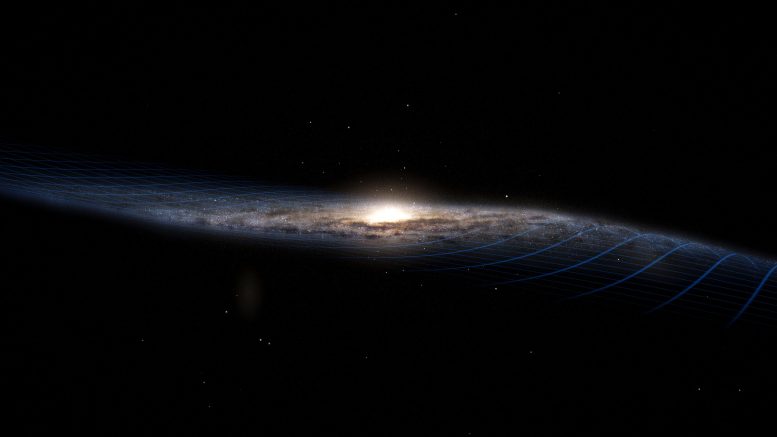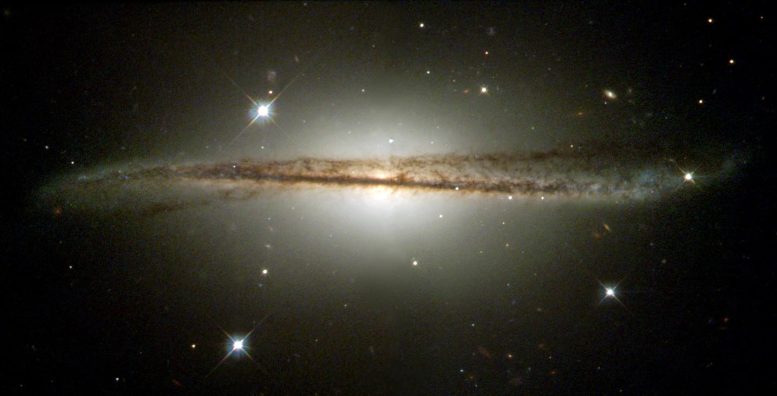
Harvard astronomers suggest the Milky Way’s warped shape is due to an irregular dark matter halo. This supports theories of a past galactic collision and offers insights into the nature of dark matter. Credit: Stefan Payne-Wardenaar; Magellanic Clouds: Robert Gendler/ESO
Astronomers’ results bolster the hypothesis of how our galaxy evolved.
The ” data-gt-translate-attributes=”[{[{“attribute”:”data-cmtooltip”, “format”:”html”}]”>Milky Way is often depicted as a flat, spinning disk of dust, gas, and stars. But if you could zoom out and take an edge-on photo, it actually has a distinctive warp — as if you tried to twist and bend a vinyl LP.
Though scientists have long known through observational data that the Milky Way is warped and its edges are flared like a skirt, no one could explain why.
Harvard Astronomers’ Discoveries
Now, Harvard astronomers at the Center for Astrophysics | Harvard and Smithsonian (CfA) have performed the first calculations that fully explain this phenomenon, with compelling evidence pointing to the Milky Way’s envelopment in an off-kilter halo of dark matter. The work also bolsters current thinking about how the galaxy evolved and may offer clues into some of the mysteries of dark matter.
The Milky Way’s galactic disk is warped and flared, similar to Galaxy ESO pictured here. NASA’s Hubble Space Telescope imaged this unusual edge-on galaxy, revealing remarkable details of its warped dusty disc and showing how colliding galaxies trigger the birth of new stars. The dust and spiral arms of normal spiral galaxies, like our Milky Way, look flat when seen edge-on. Credit: NASA/Space Telescope Science Institute
The new calculations were led by Jiwon Jesse Han, a Griffin Graduate School of Arts and Sciences student affiliated with the CfA. Published in the journal Nature Astronomy, the work includes co-authors Charlie Conroy and Lars Hernquist, both faculty members at the CfA and in the Department of Astronomy.
The Stellar Halo and Dark Matter
Our galaxy is located inside a diffuse cloud called the stellar halo, which extends much farther out into the universe. In groundbreaking work published last year, the Harvard team deduced that the stellar halo is tilted and elliptical in shape, like a zeppelin or football.
Building on that, the team assumed the same shape for the dark matter halo, the larger entity that encompasses everything in and around the Milky Way. Dark matter makes up 80 percent of the galaxy’s mass but is invisible because it doesn’t interact with light, so the shape of that halo must be inferred. Using models to calculate the orbits of stars within a tilted, oblong dark matter halo, the team found a near-perfect match to existing observations of a warped, flared galaxy.
Implications and Insights
“A tilted dark halo is actually fairly common in simulations, but no one had explored its effect on the Milky Way,” Conroy said. “It turns out that the tilt is an elegant way to explain both the magnitude and direction of our galaxy’s wobbly disk.”
Scientists had long surmised that the Milky Way formed due to a galactic collision; the astronomers’ work further underscores that hypothesis.
“If the galaxy was just evolving on its own, it would have had this nice, spherical halo, this nice, flat disk,” Han said. “So the fact that the halo is tilted and has a football-like shape suggests that our galaxy experienced a merger event, where two galaxies collide.”
“It turns out that the tilt is an elegant way to explain both the magnitude and direction of our galaxy’s wobbly disk.”
— Charlie Conroy, Department of Astronomy
Their calculation of the dark matter halo’s probable shape may also provide clues as to the properties and particle nature of dark matter itself, which remain unsolved mysteries in physics. “The fact that the galaxy is not spherical in our data implies that there is some limit to which dark matter can interact with itself,” Han explained.
Confidence in these findings might lead to better ways to cleverly study the unobservable dark matter that makes up most of the universe. This includes new ways to pick up on kinematic signatures of dark sub-halos, which are miniature dark matter halos zipping around the galaxy.
Reference: “A tilted dark halo origin of the Galactic disk warp and flare” by Jiwon Jesse Han, Charlie Conroy and Lars Hernquist, 14 September 2023, Nature Astronomy.
DOI: 10.1038/s41550-023-02076-9
Note: This article have been indexed to our site. We do not claim legitimacy, ownership or copyright of any of the content above. To see the article at original source Click Here














